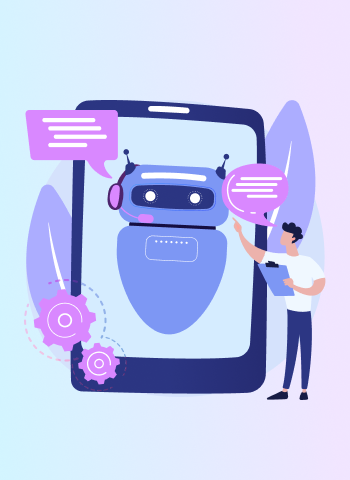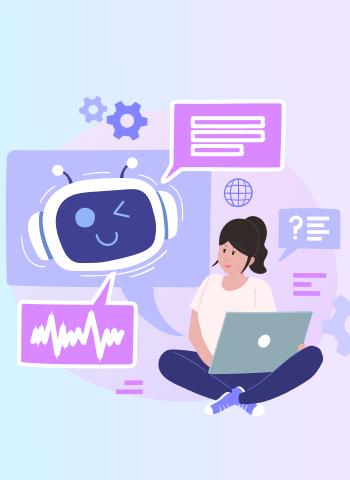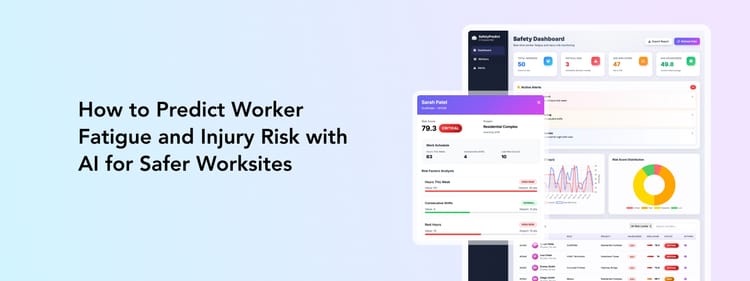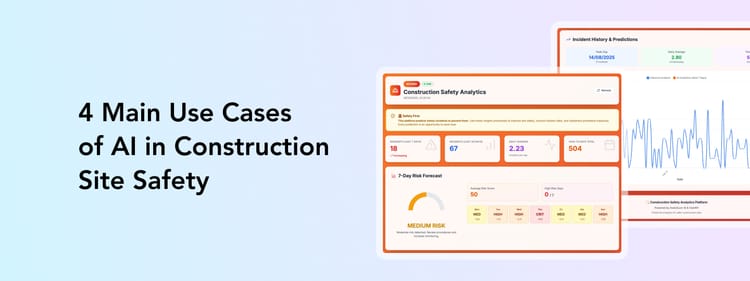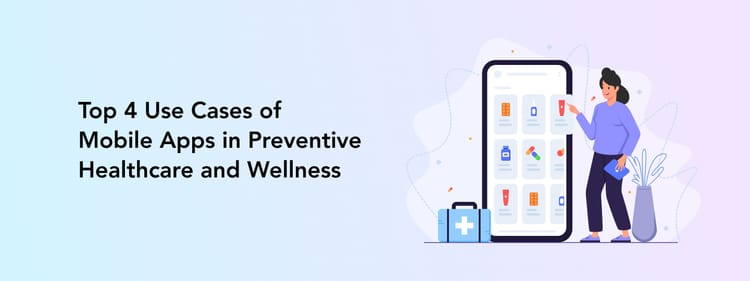If you look around in a coffee shop or a shopping mall, you might notice how many people are wearing smartwatches and fitness bands on their wrists. The popularity of wearable devices is rising: 39% of respondents in a recent survey stated that their household owns wearables.
Take an example: many users of fitness and health mobile apps would like to see their wearables versions. Think for yourself — is it more convenient to go for a run with your smartphone or a smartwatch?
It’s high time for technological companies to consider adding wearable apps to their offerings. In this blog post, we will explain how to build a wearable app and share the details about the final development cost.
Types of Wearable Devices
Let’s start with defining what types of wearable devices exist and how they match different app types.
Smartwatches
The most commonly used wearable device today is a smartwatch. From Apple Watch to Fitbit, there is a variety of options for any price range and design preference. Users can upload apps to smartwatches to receive notifications, send messages, check the navigation on a map, track fitness activities, and more. A smartwatch is a multi-functional device that can perform various tasks and replace basic smartphone functions.
Fitness trackers
Fitness trackers are similar to smartwatches in their appearance but have a more limited set of functionality. Mostly, fitness trackers allow users to record and view their activity data, such as step count, calories burned, or kilometers run. Most fitness trackers also monitor the heart rate of a user and can receive notifications from a connected smartphone.
Smart glasses
Smart glasses are a less popular wearable device yet widely used in manufacturing and engineering. Most smart glasses for Industry 4.0 (digitally-aided manufacturing) support augmented reality technology to give employees suggestions and additional information about the processes they are completing.
As for the everyday use of smart glasses, these often have audio headphone-like functionality with microphones and sometimes even cameras. Something right out of spy movies here!
Smart glasses can be used for taking phone calls, listening to music while exercising, or capturing fun moments without needing to take your phone out. And, of course, protecting your eyes from the sun.
VR headsets
Meta Quest, Sony PlayStation VR, and Oculus are the most popular VR headsets these days. Since virtual reality is not highly accessible and widespread yet, VR headset pricing is rather high. These wearable devices are mostly used for gaming and entertainment and less often for manufacturing and engineering.
Headphones
Yes, the usual pair of headphones we all have is also a wearable device. The function of headphones is plain and simple: letting us listen to audio content privately. Most headphone sets feature microphones making it possible to hop on a call too.
Health monitoring devices
Wearable devices are actively used in the healthcare industry for monitoring patients’ health parameters, like heart rate, breathing, body temperature, blood sugar levels, and sleep patterns. Wearables for healthtech come in a variety of forms, from armbands to glucose meters.
Smart clothing and shoes
Smart clothing and shoes are wearable items that contain sensors, processors, and other computing components to track information related to the wearer’s activity. In addition to tracking fitness-related data such as steps taken, calories burned, or heart rate, smart clothing can also detect movements like running or jumping.
Smart shoes usually have Bluetooth connectivity to a mobile app, so that users can check their running or exercising data without taking any devices with them. For example, some models of Nike running shoes come with built-in sensors and Bluetooth connectivity: users even get notifications when it’s time to buy a new pair.
6 Benefits of Wearable App Development
While you might be hearing about the popularity of wearable devices on LinkedIn and tech media, you might still be wondering what’s in it for you in building a wearable devices app. We give a few reasons to consider getting a wearable application.
More convenience for the users
Wearable apps are an easy way for users to view information, perform tasks, and access services without having to get on their mobile devices or computers. This can be particularly beneficial for people who are constantly on the go or have limited time in their day. With wearable apps, users can easily interact with digital content and services from any location.
A more convenient product means higher competitiveness. If choosing between a digital product that comes only in a mobile version or one that also has a wearable app, most users will lean towards the second option.
Wider market reach
Wearable apps enable businesses to reach out to potential customers that may not be interested in other tech solutions, like web platforms and solely mobile apps. By offering a more convenient platform, wearable app development allows businesses to interact with more consumers than ever before, leading to increased sales and higher customer loyalty rates.
Increased user engagement
Wearables offer users an interactive experience that is engaging and informative at the same time. One of the main uses of wearable technology, smart watches, in particular, is receiving notifications and messages without needing to look at one’s phone. Getting notifications from your app directly on a smartphone will motivate users to interact with the product and stay interested in it.
More information about your users
Introducing wearables helps companies acquire deeper insights into how their customers think and behave while also allowing them better opportunities for tailoring content that resonates with target audiences.
Being in touch with the users at all times
Wearable technology provides greater possibilities when it comes to staying connected with customers even after they’ve left your business premises or website by enabling notifications directly onto your clients’ wrists via smartwatch integration instead of email addresses like before; this helps keep you top of mind among your target audience so you never miss out on opportunities again.
Offering unique features and insights
Wearable technology offers users a more personalized experience, as the device is directly connected to the user’s body, thus providing lots of extra data otherwise unavailable. Through this direct connection to the user, the wearable application development approach can provide a detailed analysis of activity levels, sleep patterns, and overall health. This data can help inform decisions about health and well-being that are tailored specifically for each individual.
Furthermore, these apps can send timely notifications regarding preventive measures such as hydration reminders or activity goals — all designed specifically for each user based on their data.
Additionally, wearables can also act as security devices or trackers that enable real-time location sharing with friends or family when traveling in unfamiliar areas — something highly valuable in ensuring safety at all times!
Development Process for Wearable Apps
Creating a wearable app to support the main mobile product is a definite way to extend your market presence and offer a higher level of user engagement. The question is “How to build a wearable application?”
Requirement analysis and feature choosing
The first step of how to build a wearable devices application is to analyze and determine the requirements of the app. Your design and development team will ask about the device you are targeting, potential functionality, and specific use cases.
Based on your input, the design team will be defining features that will offer value to users and researching existing competing solutions. After identifying user needs, it’s important to develop an overall feature set that meets those needs.
UI/UX design
After analyzing project requirements, the next step is designing a great user experience (UX) and user interface (UI) for your wearable app. This includes creating wireframes outlining the structure of the app, the navigation inside of it, and how users will interact with your app, as well as choosing colors, fonts, and layout options for the UI elements.
The goal should be to make your wearable application intuitive and easy for users to navigate quickly and efficiently without feeling overwhelmed or confused about what they’re doing or where they need to go next within the app environment.
MVP app development
Once you have designed a viable UI/UX for your wearable application that meets user requirements outlined during the requirement analysis phase it’s time to start building out an initial version of the app called a minimum viable product (MVP).
One peculiar aspect of wearable devices app development is the operating systems of wearable apps. Even though most smartwatches are presented by Apple or Google, their OS differs from the usual iOS or Android. Apple Watches run on watchOS while Google’s Galaxy watches and other Android models run on Wear OS. Unfortunately, unlike Flutter app development services where a developer writes one code for iOS and Android, you can’t yet get one wearable Flutter app that would run on both watchOS and Wear OS.
Testing and launch
Before releasing your finished wearable app into production, it’s important to conduct some testing and make sure there are no drawbacks or significant issues in the app’s functionality. We don’t want any frustrated users, right? You can go one step further and work on beta testing: find real users who can give their honest opinion about the wearable app and rate it against a certain scale.
Once any necessary changes have been addressed it's finally time to launch! You don’t need to worry about the launch process with a reliable development team: they can take this process under their control and ensure that your app is available for the users in its best light.
Industries That Are Already Using Wearable Applications
A wearable application can be an excellent update for many digital products. Yet, some need wearables backup more than others. Let’s explore which industries rely on wearable applications today.
Fitness and wellbeing
Wearables are becoming more popular in the fitness and well-being industry. Fitness trackers and smartwatches help users monitor their activity levels, heart rate, sleep patterns, and more.
Wearable devices can provide personalized recommendations for exercise routines that are tailored to an individual’s lifestyle. Additionally, some wearables feature touch sensors or voice controls that can allow users to play music or audiobooks while exercising. All in all, wearable technology has become irreplaceable when it comes to convenient, productive, and mindful exercising.
Healthcare
Healthcare is another industry that is taking advantage of the benefits of wearable technology. Smartwatches can be used to monitor vital signs such as heart rate or blood pressure in real time.
Additionally, medical alert devices can be worn by those suffering from a chronic illness or recently discharged patients to send messages for help in case of an emergency. Smart glasses with augmented reality software have even been developed to assist surgeons during operations.
Navigation
Wearables can be used as navigational tools for long walks in unknown cities or even hiking trips. Many smartwatch navigation apps have built-in maps, even though due to the screen size, those aren’t so detailed. Most wearables feature GPS trackers that provide directions as well as information about nearby points of interest (POIs).
Communication
Messaging on wearables has become increasingly popular among people who want to stay connected with friends or colleagues without having to pull out their phones every time they receive a notification. Most smartwatches now offer instant messaging capabilities so users don't miss important messages even when they're away from their phones. Additionally, some wearables also offer voice commands which allow users to send text messages hands-free.
Challenges of Wearable App Development
The process to design and develop a wearable app differs from the process for an iOS or Android mobile app. Creating a solution for such unusual devices brings business opportunities while, at the same time, there are certain challenges connected with wearable devices application development.
Finding a skilled wearable app developer
Locating and retaining a skilled wearable app developer can be a challenge for many companies. Wearable app development requires an additional skill set from mobile app developers and knowledge of the specifics of building a wearable app. While a development company might be offering Android app development services, it’s not guaranteed that they are familiar with the Wear OS too. Because wearables apps are relatively new, there is still a relatively small pool of developers with experience in this area.
Adaptivity to a different screen size
As wearable devices come in many different sizes and shapes, developing an app that works well on all types of devices can be tricky. Developers must ensure that their code is compatible with all different screen sizes, resolutions, and hardware configurations. Additionally, they must account for how users interact with their app on smaller screens compared to larger ones by making sure all features are easy to use and accessible no matter the device size.
Limited functionality
A wearable device has less processing power, memory, battery life, and input methods. As a result, wearables designers have to be particular about which features to introduce and how to arrange all the UI elements on the screen. Additionally, developers need to consider which functionality a wearable device can handle and not overload it with complex tasks that might create lags.
Access to sensitive user data
Wearable devices often store sensitive information, such as health data or payment information, which means that developers need to ensure that their apps are secure and protect users' privacy.
How Much Does Wearable Device App Development Cost?
We have explained all the essential aspects of wearable device app development, from the process to the possible challenges. But there is one more thing most business owners would like to know: “How much does it cost to build a wearable application?”
The answer will depend on the complexity of the app, the chosen device or platform, and the team’s location. Overall, if you need to develop a wearable application to run on Apple’s watchOS and decide to collaborate with a team from Ukraine, the final price will be something between $25 000-40 000.
Future of Wearable App Development
So what does the future hold for wearable technology? The wearable device market is expected to expand at a compound annual growth rate (CAGR) of 14.6% from 2023 to 2030. This forecast speaks for itself: the presence of wearable devices will only grow and businesses of all scales need to take that into account. It’s high time to introduce a wearable app to leverage new ways of interacting with your users.
Consider Perpetio Your Trusted Partner
How can you roll out a brand-new wearable app effectively and effortlessly? By collaborating with a reliable software development partner that can provide full-cycle mobile application development services, including wearable app creating or building a wearable solution as an extension of your existing mobile application.
Perpetio’s UI/UX design and development experts have experience in adapting mobile applications to smartwatches and know how to build a wearable devices app from scratch. Add an individual approach to each client, a flexible payment system, and free business & tech consulting along the way, and there is no reason to look any further.
Perpetio is open to new projects — let us be your guides in the world of wearable application creating.
FAQ
What is a wearable app?
A wearable app is an application that runs on wearable devices, such as smartwatches or fitness bands.
What are the most popular types of wearable apps?
There are sports, healthcare&wellbeing, navigation, healthcare, and communication wearable apps. Additionally, wearable apps are used in the manufacturing industry and as supplements for mobile apps.
How is wearable app development different from traditional app development?
Wearable development requires knowledge of watchOS and Wear OS as well. What’s more, designers and developers need to take the small screen size (for smartwatches) and limited functionality of smart devices into account.
What skills are required for wearable app development?
A wearable app developer needs to be familiar with the operating systems of smartwatches, which are watchOS and Wear OS or other OS depending on the device’s type.
How can user feedback be incorporated into the development process?
Beta users can be engaged in the wearable application development process; their feedback can be used for fixing inconsistencies in the stable version release. Additionally, you can collect feedback on the App Store and Google Play to make changes to the app.
What are the future trends in wearable app development?
We can expect that wearable technology will only grow in the future with wearable devices acquiring wider functionality.

